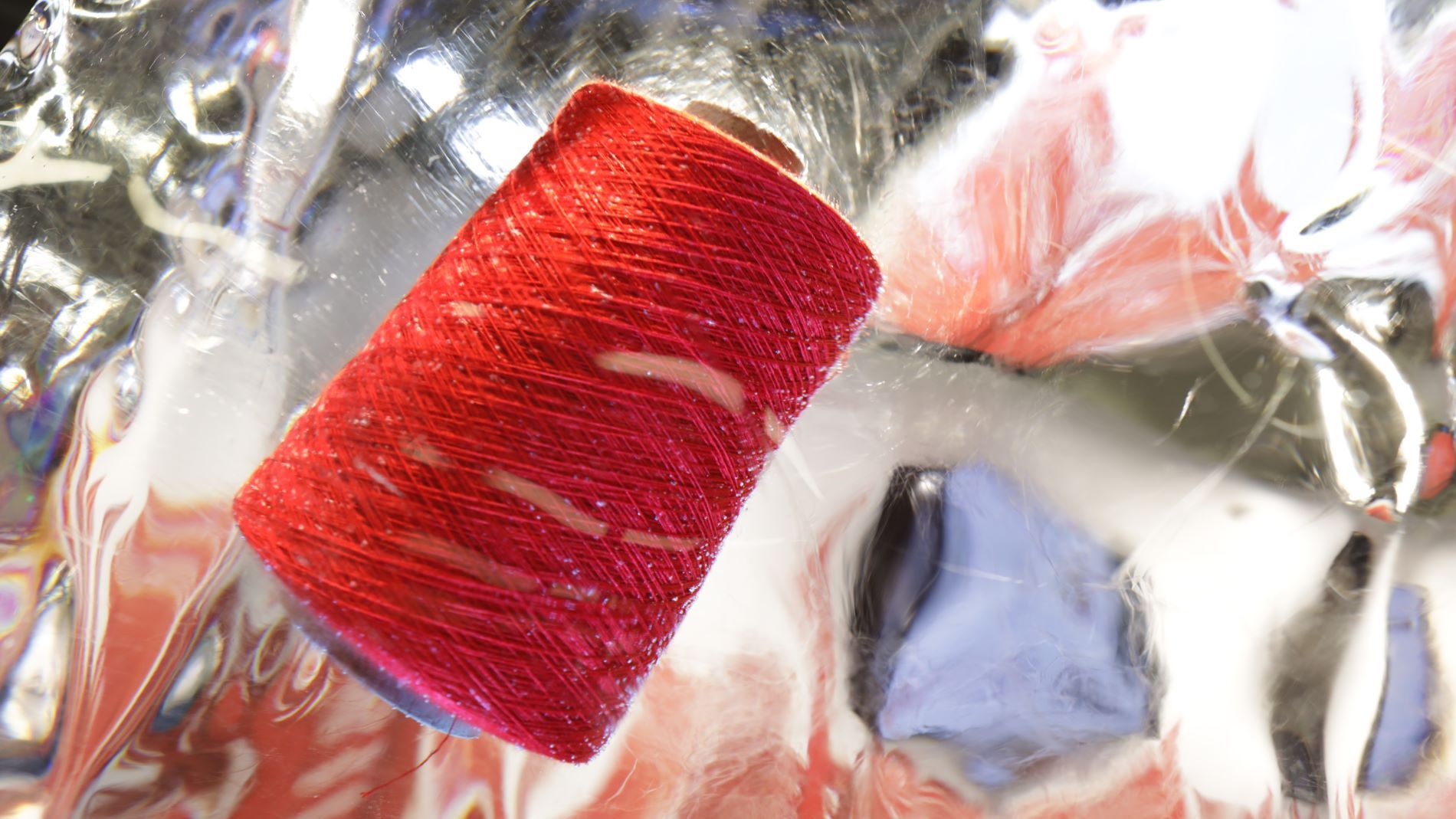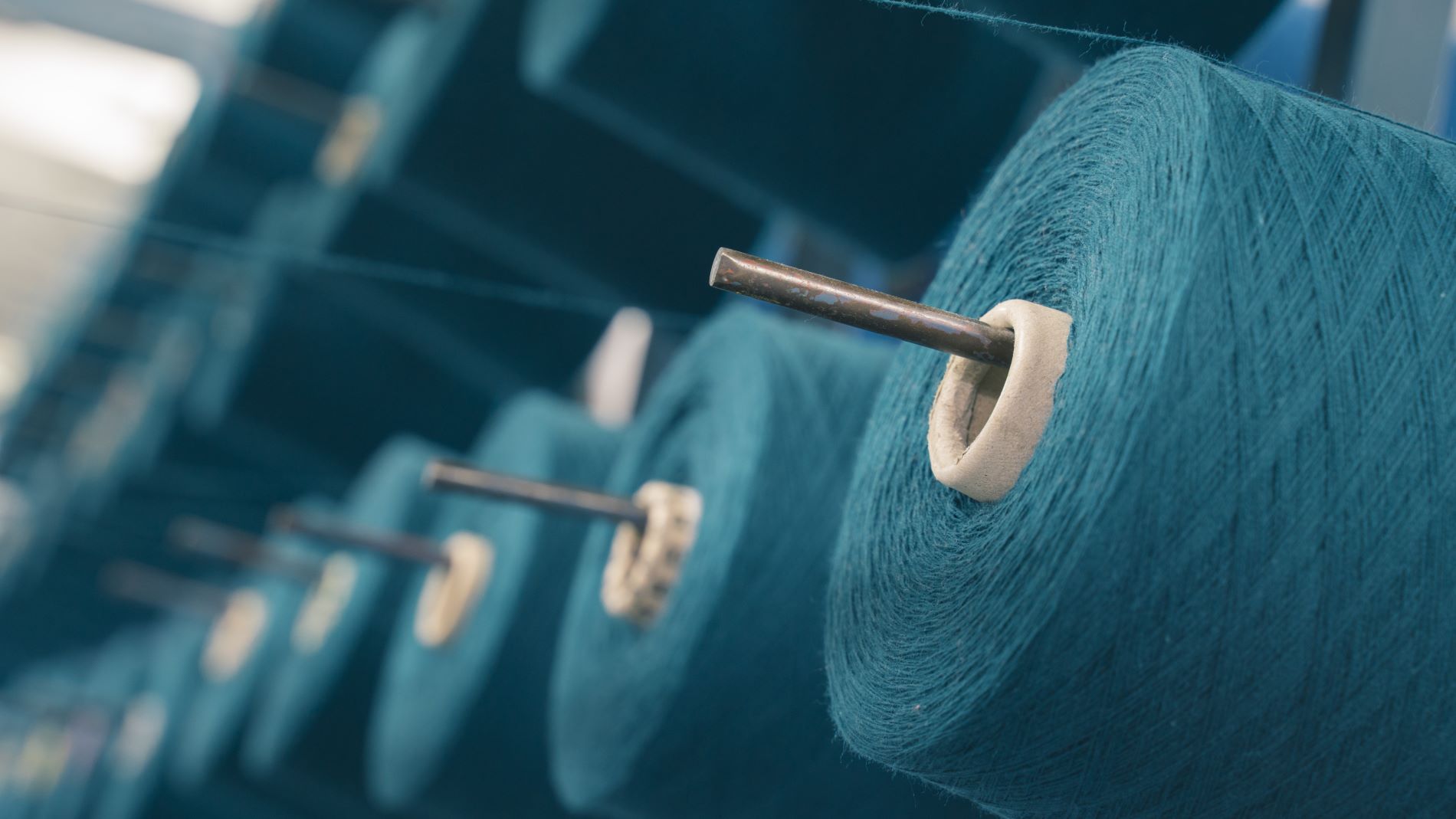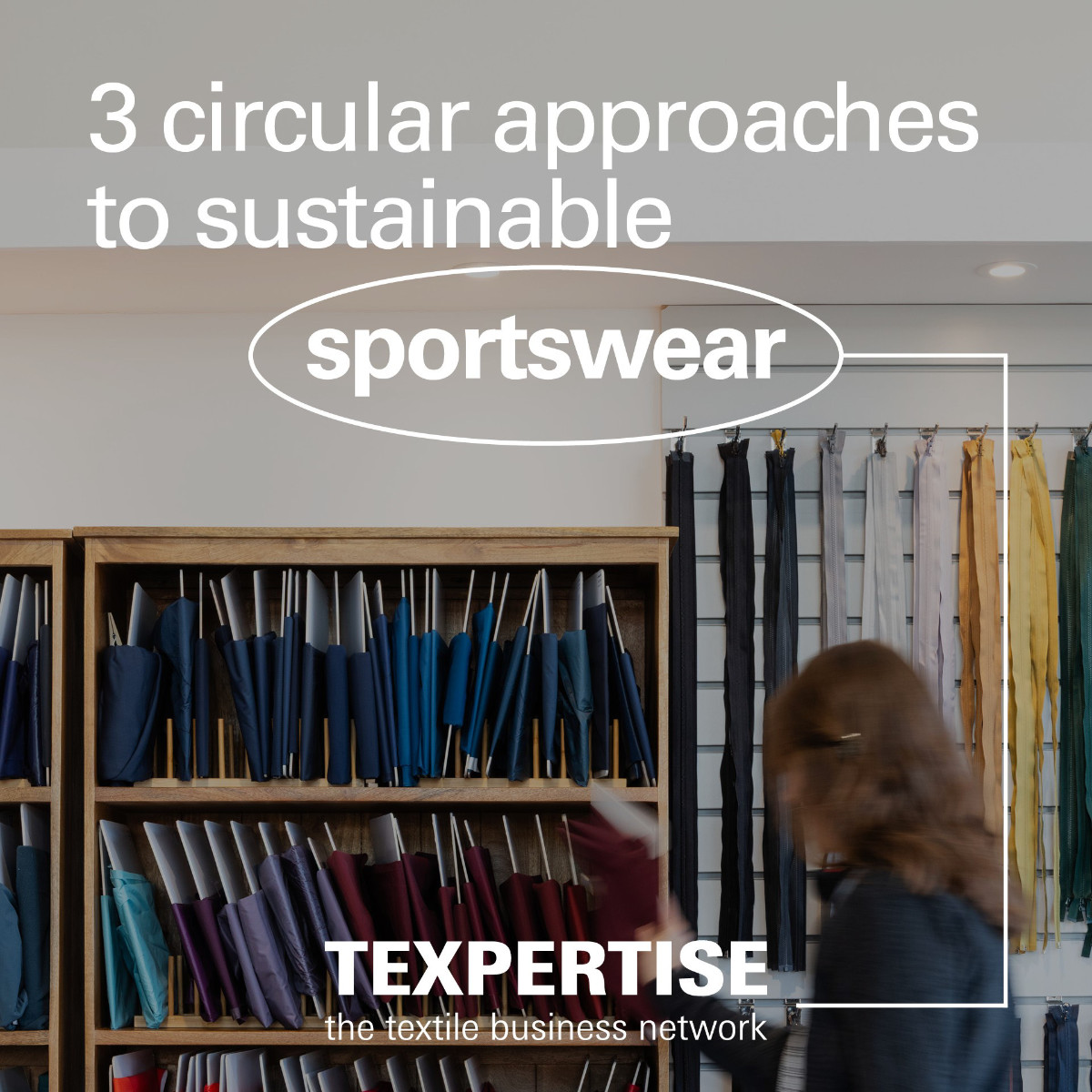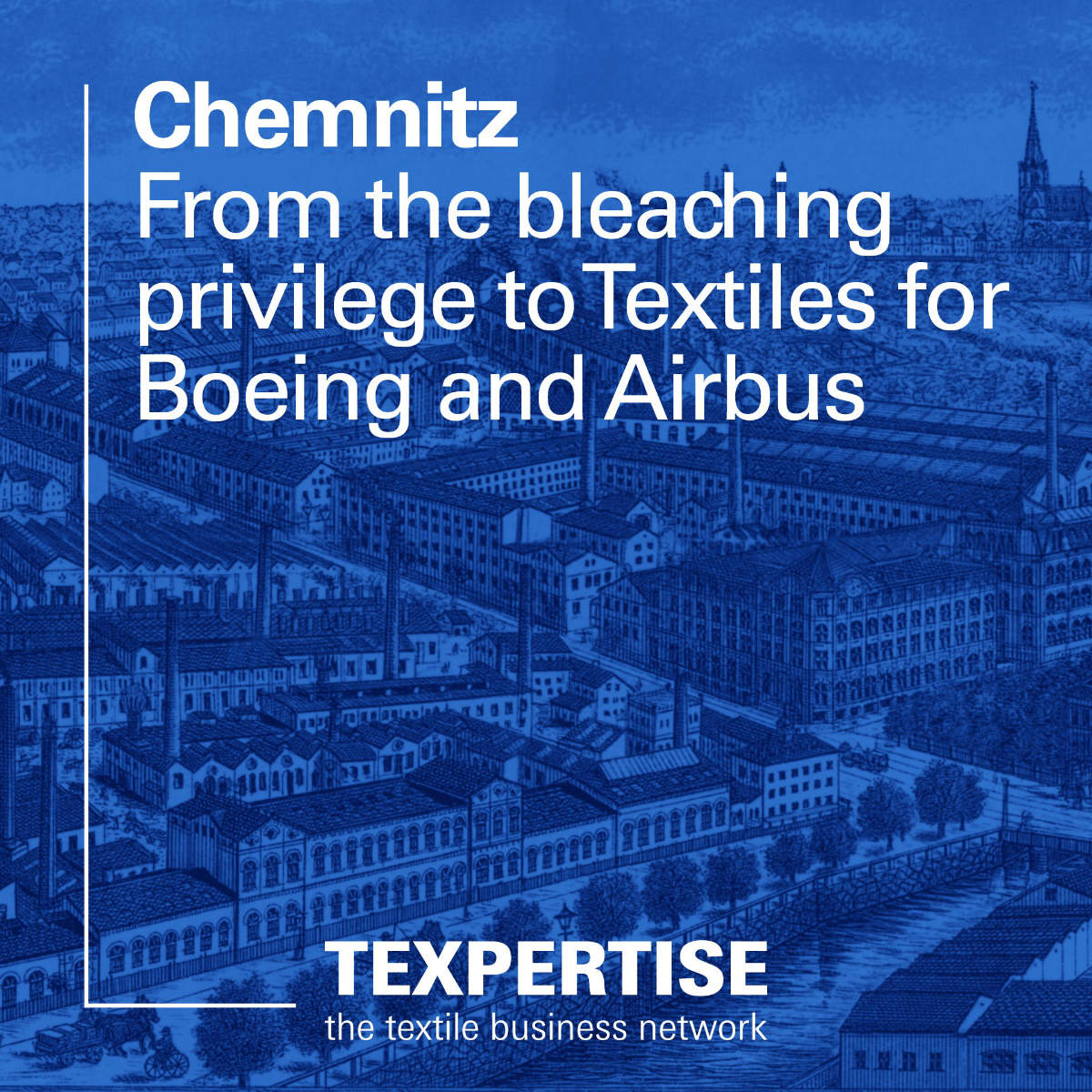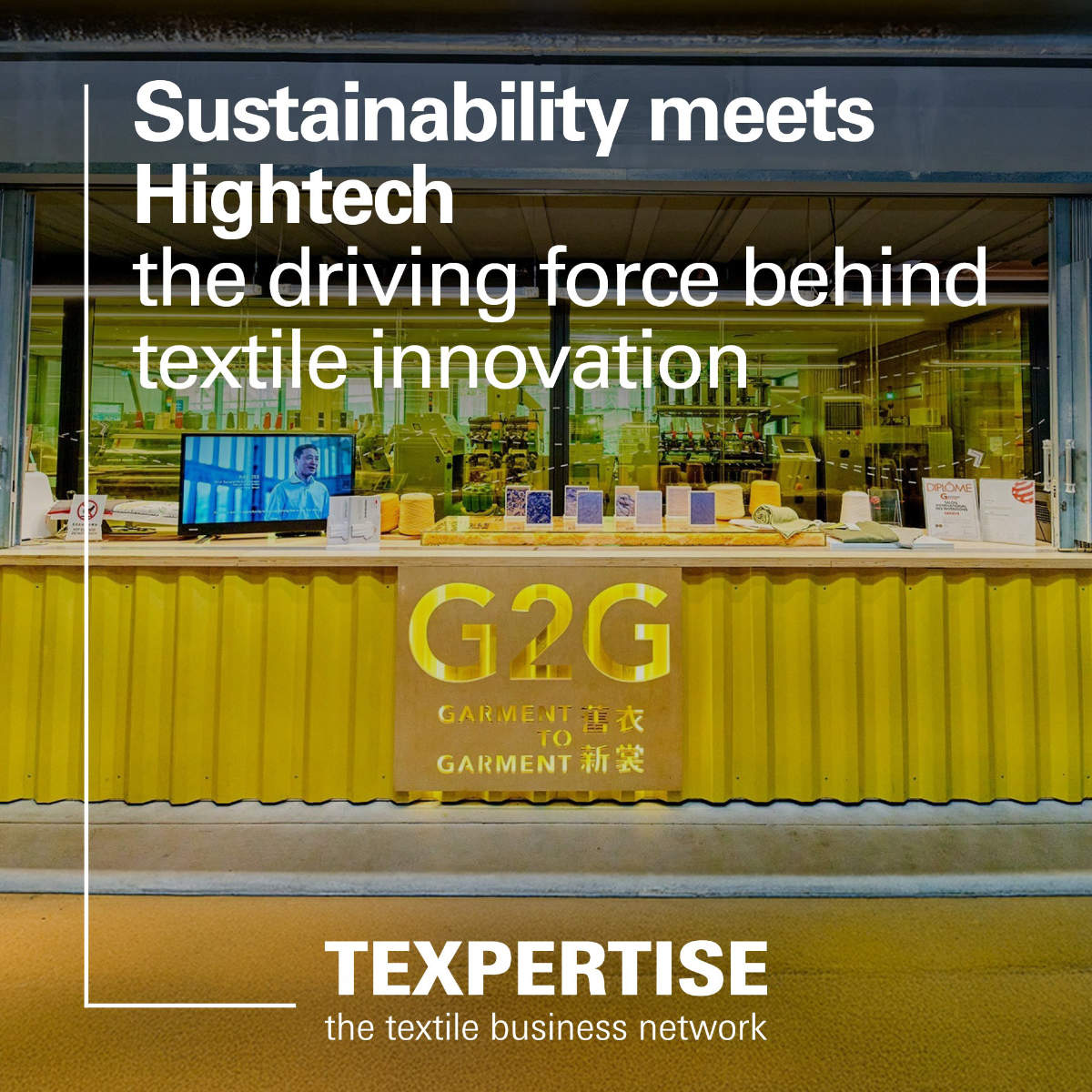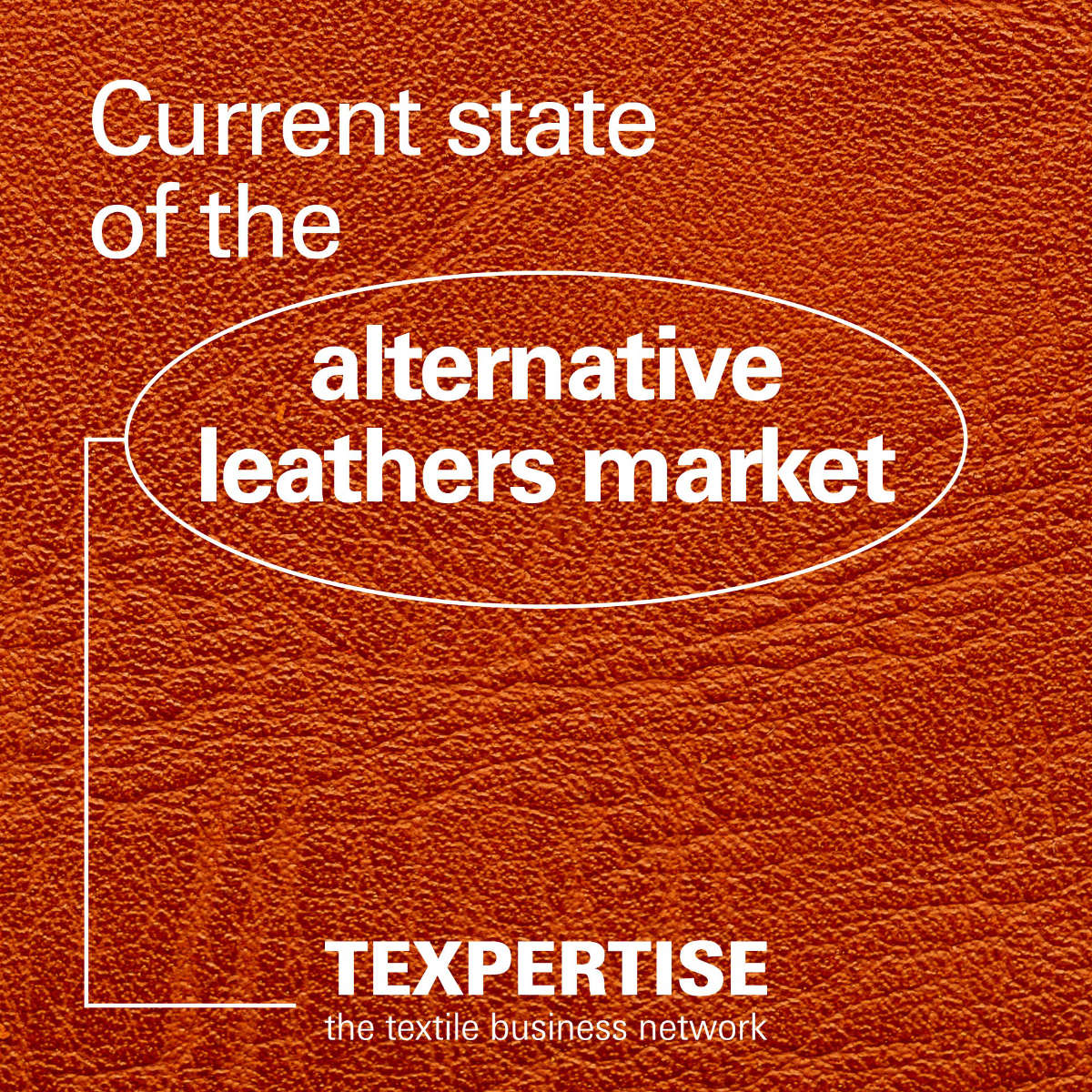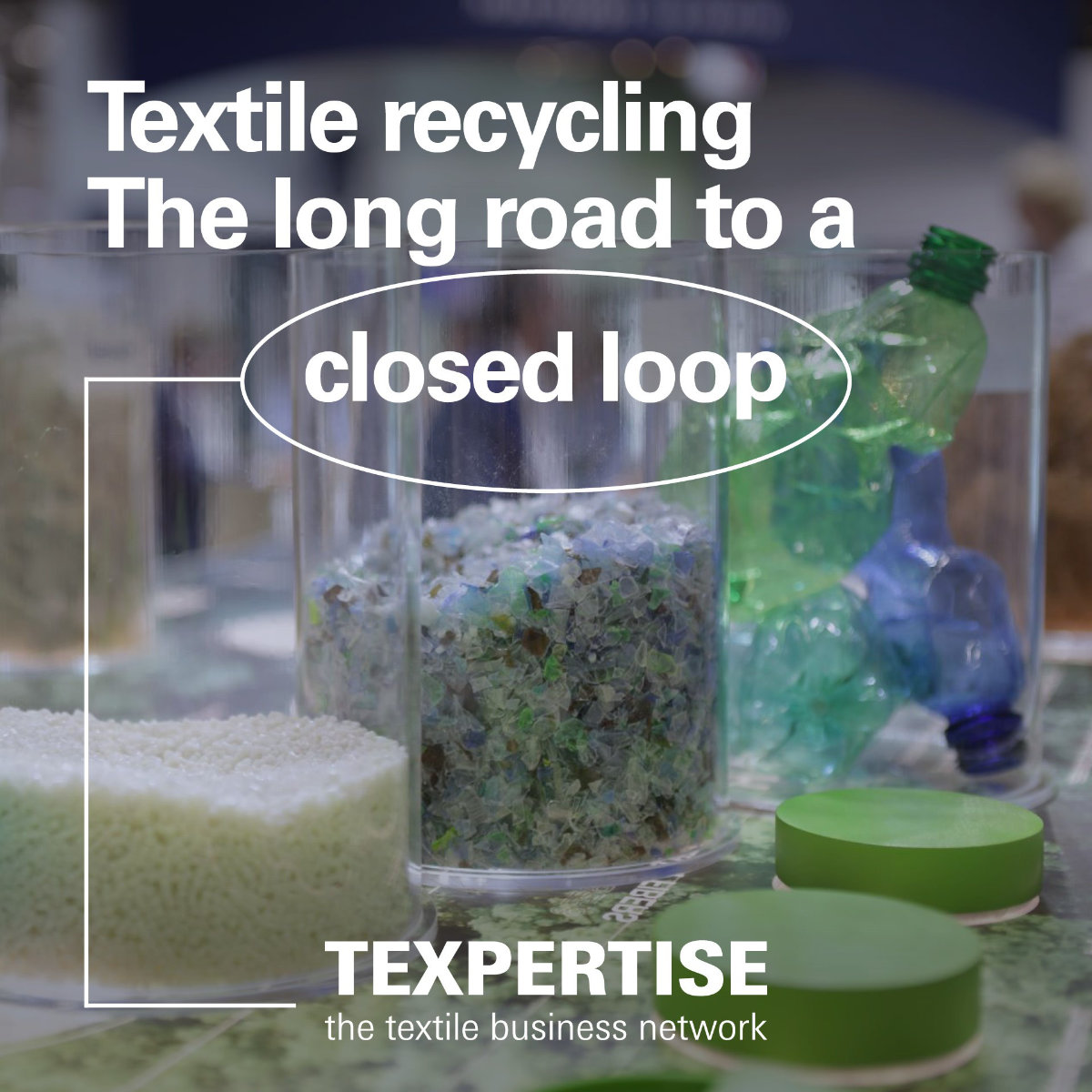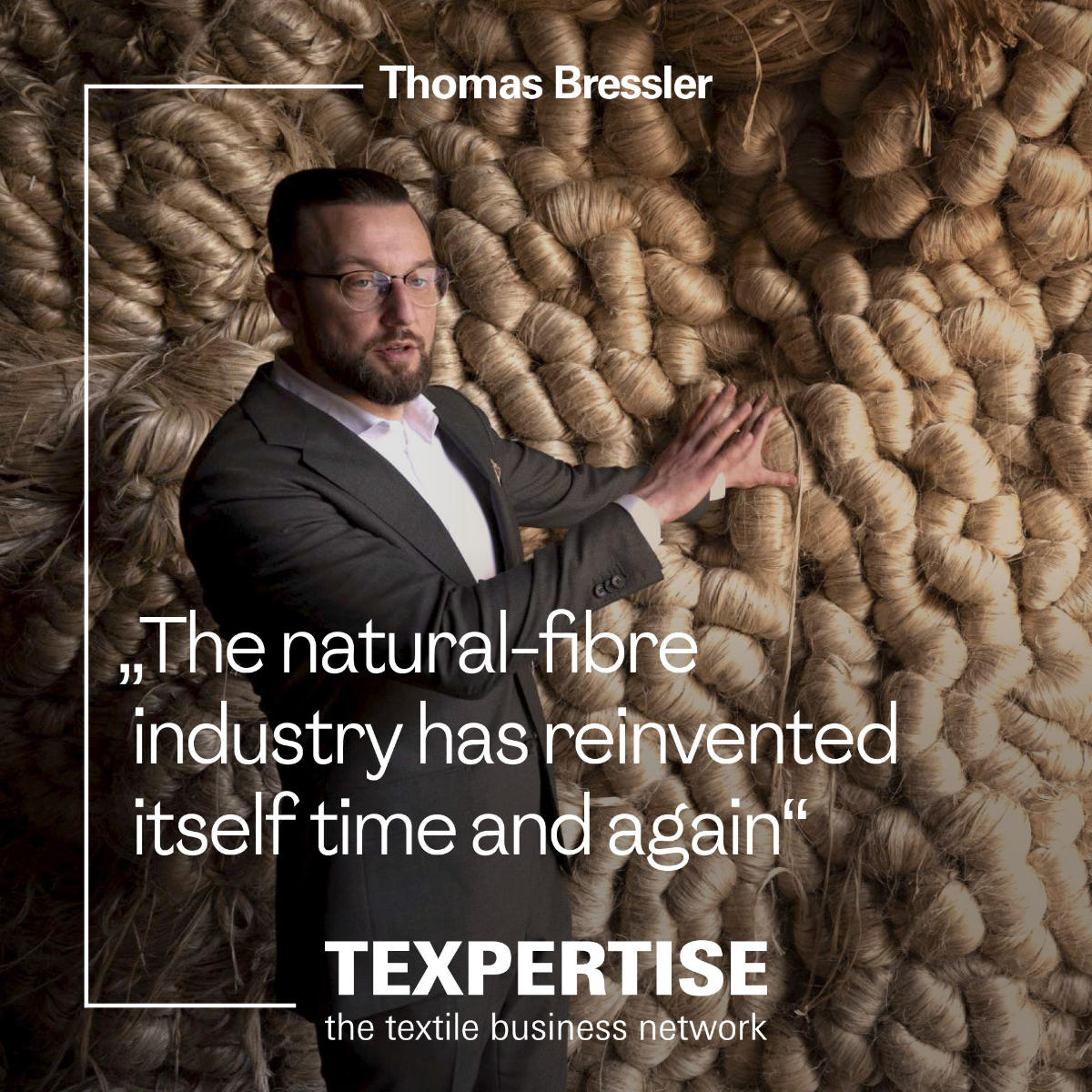Reading time: 7 minutes
Synthetic fibres dominate the market.
According to the Materials Market Report 2024 by Textile Exchange, global fibre production reached a new high of 124 million tonnes in 2023. If this trend continues, 160 million tonnes are expected by 2030. With a share of 57 per cent, polyester remains the most-produced fibre.1 The reasons for the leading role played by synthetics are well-known: they are highly available, very versatile and cost-effective. Their low production costs continue to make synthetic fibres the preferred material in a number of applications. Not only are they used in everyday clothing and home textiles, but also in seat belts, airbags, filters, surgical suture material, blood vessel prostheses and in the functional outdoor clothing that is particularly popular today. But they have distinct environmental disadvantages: synthetic fibres are based on fossil raw materials, their manufacture is energy- and CO₂-intensive, they are not easily degradable and they release microplastics.
It is also the case that recycled synthetic fibres are increasingly being used, such as recycled polyamide (nylon), which is sourced from industrial waste, old carpets and discarded fishing nets or recycled polyester (rPET). In comparison to new (“virgin”) synthetic fibres, both of these contribute to relieving the burden on the environment, but they are also not biodegradable and also release microplastics. Another dilemma is that the vast majority of rPET does not come from a closed textile loop, but recycled PET bottles. This form of recycling outside the industry does not correlate with the goal of having a circular textile economy. High-quality fibre-to-fibre recycling where old polyester textiles are processed into new textile fibres has so far hardly been employed. In this respect, the mixed fibre textiles that are common today present the industry with major challenges. But the textile industry is working on solutions: biobased plastics such as PLA (polyactide) from renewable raw materials such as maize or sugar cane are one option. They are admittedly not automatically biodegradable but have similar characteristics to standard synthetic fibres and can be processed using the same machines. Furthermore, textile companies are producing polyester alternatives that are largely biodegradable and can also compete with conventional polyester in terms of durability and performance. Parallel to this, plant-based dyes are also being worked on, which could make the use of synthetic fibres more sustainable in the long term.
Natural fibres: from a trend to a standard?
While the textile industry is looking for solutions to the environmental challenges posed by synthetic fibres, one question remains: could natural fibres be the key to a more sustainable textile industry? Their longer manufacturing process and climatic dependencies may mean that natural fibres are often less economically viable than synthetic fibres, but they do have some crucial advantages when it comes to sustainability: they are renewable, biodegradable and free of microplastics. They also bind CO₂ and enable closed loops. But looking at the production figures is sobering: even though cotton, the most important natural fibre in the world, achieves a substantial annual production volume of 24 to 25 million tonnes2, which is around 20 per cent of the global fibre market3, the vast majority goes into clothing. In this industry, cotton, like linen, is particularly popular for its breathability, gentleness on the skin and comfort. Other natural fibres such as jute, flax (linen), coconut, sisal, hemp, ramie and kapok4, by contrast, only achieve single-figure percentages in terms of annual fibre production. This is why natural fibres are often referred to as “niche” and “trend”. That said, there are promising developments on the horizon. Natural fibres are gaining in importance as consumers start to behave in a more environmentally conscious manner. This was confirmed by a McKinsey survey from 20205: out of the more than 2000 British and German consumers who were surveyed, 67 per cent said that using sustainable materials would be an important purchasing factor for them. A consumer study by the online portal Utopia in 20246 showed that this trend still persists, even in difficult times: despite economic pressure due to inflation, 44 per cent of the German population aged 18 and above, and therefore 3 per cent more than in 2022, remain open-minded where sustainable offerings are concerned. While the group of “occasional” buyers of sustainable products has slightly decreased due to higher price sensitivity, the core group of sustainability-minded consumers has remained stable.
Regulation and new markets are driving the demand for natural fibres
Another driving force in the use of natural fibres is new legislation: ‘The EU’s textile strategy and increasing sustainability requirements in particular have led to a growing interest in natural fibres’, says Stefan Schmidt, Head of the Technical Textiles Department & Consultant for Research, Technology and Sustainability at the German Industrial Association for Finishing, Yarns, Woven Fabrics and Technical Textiles (IVGT). The German Association of Home Textiles Manufacturers also confirms the increasing use of natural fibres: ‘At present, we’re seeing three major trends in home textiles: biodegradable products, the use of recycled materials and the increased use of natural fibres’, says Managing Director Martin Auerbach. Natural fibres have a natural home in the home textiles field partly because of the coarser yarn structure of home textiles. In addition to cotton, this means that a variety of other natural fibres can also be used, such as hemp, jute, banana and coconut fibres. Another advantage is that in contrast to fast-paced fashion, consumers are more open to accepting higher prices for long-lasting home textiles; according to a 2023 multinational study by the Centre for Research in Retailing in Cologne, this amounts to approximately 64 per cent of consumers surveyed.7
Additional Spending on Sustainability
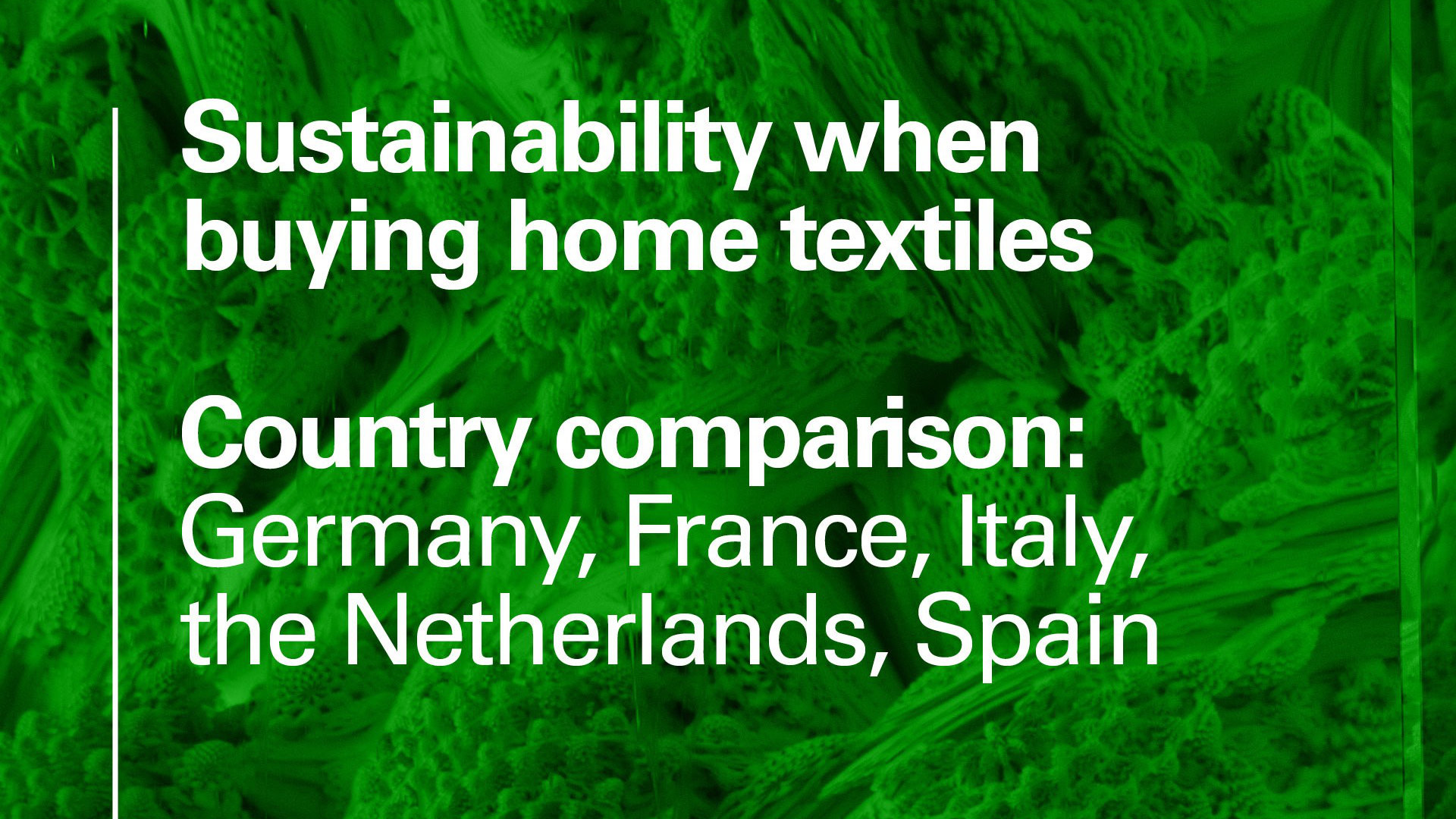
Overall, most consumers (around 64 %) in Germany, France, Italy, the Netherlands and Spain are prepared to spend more on sustainable home textiles. At country level, there are clear differences in terms of sustainability when buying home textiles.
Technical applications as a future field
At the same time, natural fibres also demonstrate their natural advantages for applications such as insulation material, erosion control mats and biodegradable packaging materials as an alternative to polystyrene. In the automotive industry, they are establishing themselves as the environmentally friendly alternative to synthetic fibres, predominantly in interiors or in the form of fibre composites. The challenge is that, as a natural product, natural fibres are subject to variations, making scalable production that maintains fibre quality difficult. For technical uses, synthetic fibres continue to be preferred because of their better reproducibility, functionality and definable property profiles. However, innovative manufacturing, processing and finishing methods can contribute to reducing the quality variations in natural fibres and make them suitable for an ever increasing range of technical applications, particularly in mixed textiles that combine the functional advantages of synthetic fibres with the environmentally friendly aspects of natural fibres.
Bridging the gap between functionality and sustainability
To overcome the functional differences between natural fibres and at the same time produce sustainably, the textile industry is relying on a third option: man-made cellulosic fibres (MMCF) from renewable raw materials such as trees or other plants. These “semi-synthetic” fibres, which are industrially processed and chemically modified into a spinnable form, have assumed a special position: like natural fibres, they are biodegradable and free of microplastics, and like synthetic fibres, they offer consistent quality, scalability and definable properties in terms of feel, strength and moisture management. The demand for MMCF is rising continuously, as proven by the annual production volumes cited since 2000: back then, the annual production volume of MMCF globally was just 2.64 million tonnes8, while by 2023 it had tripled to 7.9 million tonnes9 with an average growth rate of around 5 per cent per year. Currently, MMCF make up around 6 per cent of the global fibre market. With a share of 80 per cent, viscose (rayon) dominates the market, followed by acetate, modal and cupro10. One of the best-known cellulose fibres is lyocell, which has been distributed by Lenzing AG under the brand name TENCEL™ since 1992. The Austrian company confirms that demand for lyocell fibres is still rising even in the current difficult market environment, despite high price sensitivity: ‘At the moment, we estimate an average annual growth rate of 20 per cent for lyocell fibres, which makes Lyocell/TENCEL™ one of the fastest growing fibres in the world.’
“Currently, Man-Made Cellulosic Fibers (MMCF) make up around 6% of the global fibe market.”
‘A shirt becomes a potato’
Overall, natural fibres and MMCF offer huge potential for the sustainable transformation of the textile industry. But there are also challenges associated with this: cultivation areas must be used more efficiently, expanded without competing with food growing and climate-related crop failures due to extreme weather events factored in. Responsible cultivation methods are needed, such as the optimisation of water use in cotton cultivation and reforestation. In an ideal world, to ensure true sustainability, supply chains should be transparent right back to fibre production. There is a need for research and development into cultivation and production methods in order to e.g. offset the varying quality of natural fibres, achieve industrial standards for scalable and reliable production and manage the chemicals used in MMCF production within a closed loop. Given the CO₂-intensive transport routes of biobased fibres, IVGT expert Schmidt also sees potential in local value creation: ‘The choice of fibre influences the environmental footprint of the textile product as a whole. To ensure true sustainability, we need to establish a network of textile micro factories that use local raw materials for fibres. We would no longer need a textiles bin, because a shirt could be thrown onto the compost and become a potato the next year.’
Key Learnings
- Synthetic fibres dominate the market Synthetic fibres appeal because of their availability, versatility and low production costs. Disadvantages include the fact that they consume fossil raw materials, have high energy consumption and they release microplastics. Recycled variants are available. True fibre-to-fibre recycling is still not very widespread.
- Natural fibres have growing potential Advantages include their biodegradability and CO2 binding. Their use is driven by more environmentally conscious consumer behaviour and legal requirements, including in home textiles and technical textiles. Challenges include climatic dependencies and scaled use.
- Regenerated fibres can bridge the gap between chemistry and nature Man-made cellulosic fibres combine the advantages of natural and synthetic fibres. The demand for these is growing rapidly. Innovations in cultivation and production can solve quality and scaling problems.
Sources:
1 Textile Exchange, 2024, “Materials Market Report”
2 Textile Exchange, 2024, “Materials Market Report”
3 Statista.com, 2023, Distribution of fibre production worldwide
4 Statista.com, 2023, Distribution of fibre production worldwide
5 McKinsey, 2020, “Survey: Consumer sentiment on sustainability in fashion”
6 Utopia.de, 2024, ‘Everything remains different’ (German only)
7 IFH Köln GmbH, December 2023, “Sustainability of home textiles”
8 Statista, 2024, “Chemical fiber production worldwide from 2000 to 2022”
9 Textile Exchange, 2024, “Materials Market Report”
10 Statista, 2024, “Distribution of manmade cellulosic fibes (MMCFs) production worldwide in 2022”
